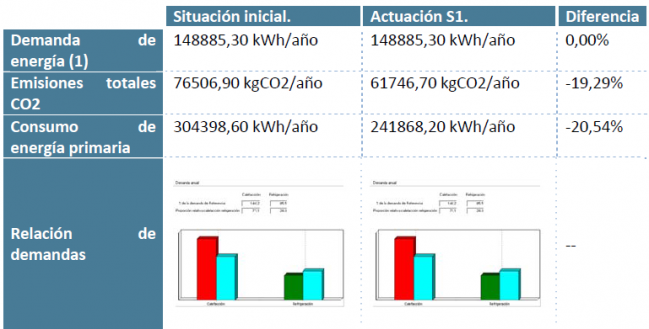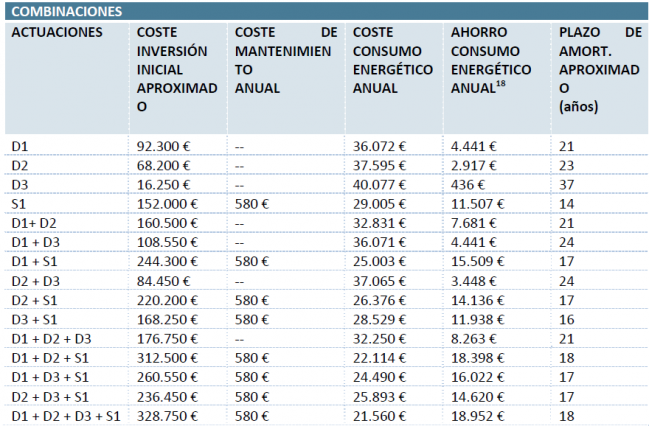-
Phone Number
-
Email Address
In this article we will describe an example of energy rehabilitation that is included within the presentations and talks that are part of the 1st Biennial of Building and Sustainable Urbanism , in Specifically, the one corresponding to a pilot case in the neighborhoods road from Cádiz to Málaga.
The following case study was carried out by Fernando Gutiérrez Garrido together with Daniel Rincón de la Vega, a few years ago in Congress Greencities.
Content menu:
The building corresponds to a block of 34 rental homes Limited with commercial basements, located on the corner of the Heroes de Sostoa and Velasco streets in Malaga. Building It has two facades facing Northeast to the street Velasco and Southwest on the rear façade. presents a total of 10 floors of apartments with two typologies that are kept in levels 1 to 4 and 5 to 10.
The distribution of the dwellings corresponds to the habitual of that time with three and four bedrooms, a bathroom, kitchen, utility room and living room, and its shape and distribution hinders correct cross ventilation in them. It presents a foundation and structure made of concrete armed.
The exterior facades have a total thickness of 25 cm, and present a composition from the outside to the inside formed by hollow brick partition, chamber and brick partition hollow, with exterior finish by plastering and painting.
It presents a resolved roof with rabbit partitions on the slab of the last floor, on which rests a rasilla board finished with compression layer and arabic tile. It presents metallic exterior carpentry and has roller blinds. It has double glass as indicated in memory, but the thickness is not defined.
To model the building we have used the CALENER VYP program , with which Obtain the demands and energy consumption for heating and cooling as well as CO2 emissions.
A simulation of the building in its current state has been proposed to know the demands and energy consumption, and from this way to analyze the possible improvement actions for the rehabilitation of the building. Thus, three actions are proposed aimed at reducing demand and another to reduce consumption of non-renewable energy, being the following:
In this first example, energy rehabilitation takes into account Note that the thermal transmittance value is higher than the required by the Technical Code for the climatic zone of reference (zone A3). To meet the established requirements, it is necessary to increase the insulation so that its thermal resistance will be the next:
[highlight]U[/highlight]CTE: 0.94 W/m²K (R: 1.06 m²K/W)
[highlight]U[/highlight]BUILDING: 1.40 W/m²K (R: 0.71 m²K/W)
[highlight]R[/highlight]BUILDING + [highlight]R[/highlight] THERMAL INSULATION REQUIRED = RCTE
[highlight]R[/highlight]INSULATION THERMAL REQUIREMENT: 0.35 W/m²K
Extruded polystyrene with conductivity 0.038 is chosen W/mK, made of wood that requires lining on the outside with the following thickness:
e = R ∙ λ = 0.35 W/m²K x 0.038 W/mK =0.0133 m = 1.33 cm
A lining on the outside has been proposed, with a insulation thickness of 3.00 cm with insulating material of conductivity 0.038 W/mK. So the transmittance of the facade of the improved building will be:
[highlight]U[/highlight]BUILDING IMPROVED : 0.66 W/m²K (R: 1.51 m²K/W)
With this scenario, energy savings are obtained in energy demands and emissions that are expressed in the following table:

According to the constructive solutions of the project, this presents metal windows without thermal bridge break with double glazing, with the following characteristics:
Hole transmittance U: 5.60 W/m²K
Solar factor 0.68
The frame rate is considered to be 18%, with a absorptivity of value 0.8 (dark frame) and solar factor of 0.80 value glass. The gap percentages in each guidance are as follows:
The thermal transmittance of the holes, for each orientation presents the following deviation, with respect to the limit values:
It is proposed to replace carpentry and glass with other PVC and double glazing 4+9+6 that meet the minimum established in the CTE for each orientation.
[highlight]U[/highlight] CTE: 2.86 W/m²K, FS CTE: 0.63
In this second case the following savings are obtained energetic:

In this case the thermal transmittance of the roofs is 1.04 W/m²K, 108 % higher than the value limit required by the basic document DB‐HE for the reference climatic zone (zone A3). In order to strictly comply with the established requirements, requires an increase in the insulation level with the following value:
[highlight]U[/highlight] CTE: 0.50 W/m²K (R: 2.00 m²K/W)
[highlight]U[/highlight] BUILDING: 1.04 W/m²K (R: 0.96 m²K/W)
[highlight]R[/highlight] BUILDING + [highlight]R[/highlight] REQUIRED THERMAL INSULATION = RCTE
[highlight]R[/highlight] INSULATION THERMAL NEEDED: 1.04 W/m²K
Extruded polystyrene with conductivity 0.038 is chosen W/mK, so a lining is needed on the outside with the following thickness:
e = R ∙ λ = 1.04 W/m²K x 0.038 W/mK =0.03952 m = 3.95 cm
A lining on the outside has been proposed, with a insulation thickness of 4.00 cm with insulating material of conductivity 0.038 W/mK. So the thermal transmittance of the roof of the improved building will be:
[highlight]U[/highlight] BUILDING IMPROVED : 0.49 W/m²K (R: 2.04 m²K/W)
In this case the following improvements are achieved with respect to to the initial situation:

The incorporation of collectors on the roof is proposed solar for ACS, so that an installation with centralized accumulation and distributed support that meets the minimum solar contribution required in the DB-HE4.
Climatic zone: IV
Reference demand: 22 liters per person
Reference temperature: 60 ºC
Occupancy: 152 people
Total demand: 3344 liters
Support energy source: Natural gas
Proposed solar contribution: 70%
In this last case of improvement, evidently the demand energy is maintained since it does not act on the envelope, but Yes, it improves energy consumption and emissions according to the following table:

From these four improvements, several scenarios in which these hypotheses are combined, obtaining the following savings with investment costs and lead times amortization indicated:

It starts from the main criterion whose objective is the reduction of energy demand of at least 30% of in accordance with the specifications contained in article 20 of the Actions eligible for the State Development Plan of rental housing, the rehabilitation construction , and urban regeneration and renewal, 2013‐ 2016. To do this, the chosen action must be modified until reducing an additional 3.19% the energy demand in the building on that produced by the chosen action. Them and achieved by increasing the thickness of the proposed exterior insulation for the facades, so that the definitive intervention is the one specified:

With these new actions proposed, the intervention is eligible and even if the cost of the investment is slightly higher than the initial one, the amortization term is reduced by one year.
The incorporation of thermal insulation in the facades of these Limited Rent buildings represent an economical, constructive and architecturally viable to enhance the thermal behavior of buildings.
With the replacement of carpentry and glass, a viable intervention both from the point of view both economically and constructively speaking, achieving improve other features of the building in parallel such as protection against noise and air quality interior (with the incorporation, where appropriate, of aerators).
When it comes to improving by incorporating thermal insulation on deck in blocks similar to the one analyzed there is no significant reduction in demands, energy consumption and emissions.
Incorporate thermal solar energy through solar collectors is feasible in case of comprehensive interventions, since it is can optimize the performance of equipment and the number and disposition of the same.